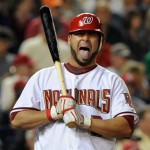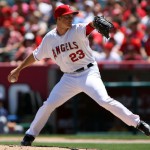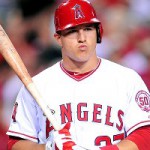
Jesus Flores remains our most successful Rule 5 Draftee. Photo Toni Sandys/Washington Post
The Rule 5 draft is being held on December 6th, 2012 at the annual Baseball Winter meetings. Frequent readers of this and other Nats blogs are well aware of the Rule 5 draft; the Nats have been frequent participants in the Rule 5 draft process, somewhat to the ire of other teams (who I suspect lately have been “returning the favor” by taking players from us and sitting on them for a year, as mentioned below).
Most scouting pundits bemoan the changes made to the CBA, saying it gutted the Rule 5 draft, but it has still featured some pretty significant names even in recent years. Guys like Dan Uggla, Johan Santana, Shane Victorino, Joakim Soria, Josh Hamilton, RA Dickey, Scott Diamond and Evan Meek are all example draft picks from the past few years. So I believe the draft is still important and can lead to significant players changing hands.
I split this post into two parts: Below we’ll review the Nats Rule 5 draft history. Then in Part II tomorrow we’ll talk about our own possible rule 5 players warranting protection, and then talk about what the Nats may be looking for in 2012’s rule 5 draft.
Part I. Nationals Rule-5 draft history
Baseball-reference (of course) has Rule 5 draft results from recent years. Here’s a list of the Rule 5 drafts since 2005, with our players taken/received noted and with some thoughts on how the player turned out for either side. Note i’m only doing this analysis for the major league section of the rule 5 draft; there’s just far too little eventual MLB success to be found in the AAA and AA sections of the Rule 5 draft to do the analysis.
2004 Rule 5 Draft (ahead of the 2005 season)
- Tony Blanco: 1B; Drafted from Cincinnati. He batted .177 as a 1st baseman backup while eating a roster spot all season, then we cut him from AAA after 2007. He kicked around Colorado’s system for a year and has been playing in Japan ever since. Verdict: failure.
- Tyrell Godwin: CF, Drafted from Toronto. Prior to the 2005 season, the team traded another minor leaguer to keep his rights, so this really played out less like a rule-5 pickup in that Godwin didn’t have to stick on the 25-man roster all year. He played a grand total of 3 games for the Nats, kicked around AAA for a while an hung them up in 2007. Verdict: failure.
2005 Rule 5 Draft
The Nats did not draft anyone, but had a player drafted themselves who went on a whirlwind tour of MLB organizations before getting returned mid 2006. Chris Booker was rule-5 drafted by Detroit, who immediately sold him to Philadelphia, who then waived him in May of 2006 with the intent of returning him … except that Kansas City picked him up, hung onto him for a couple months and eventually returned him to Washington. The Nats eventually called him up but he was relatively ineffective and he washed out of the game (likely due to injuries) after 2008.
2006 Rule 5 Draft
- Jesus Flores, C, drafted from the New York Mets, stuck with the team all year despite having only played high-A ball in the minors. Despite his downslide and injury issues, Flores remains the hopeful “found gold” prospect that can be had in the Rule 5 draft. Verdict: success.
- Levale Speigner RHP (a closer) was drafted from Minnesota and, as with Booker above, eventually was traded for by the Nats so they could keep him and stash him in the minors. After some awful outings for the big team, he passed through waivers mid 2008 and was released from AAA in 2008, bounced around a couple other organizations, and retired after 2010. Verdict: failure.
The Nats lost one player in this draft: Alejandro Machada was drafted by Minnesota just a month after the Nats had re-signed him to a minor league contract. So Machada didn’t have to stay on their active roster. And indeed he didn’t; he was injured all of 2007 and stayed with Minnesota’s AAA team until 2009, never again broaching the majors.
2007 Rule 5 Draft
- Matt Whitney: 1B/3B, Drafted and then eventually returned back to Cleveland, who eventually made the former 1st rounder a ML free agent and we signed him after the 08 season. We cut him after the 2009 season and he retired after 2010. Verdict: failure.
- Garrett Guzman: LF/RF: after Rule-5 selecting him, the team eventually traded a PTBNL for him to Minnesota, then we cut him outright and nobody picked him up. He played two years of Independent ball and is out of baseball after 2010. Guzman is more infamously known as the player who was caught having sex with an underage girl while playing for our AA team in Harrisburg in 2008, likely the reason why nobody picked him up after his DFA. Verdict: failure.
2008 Rule 5 Draft
- Terrell Young: Drafted with the #1 pick in the Rule 5 draft from Cincinnati. He got hurt, never played for us, and was eventually returned to the Reds. His injury was severe enough that he was out of baseball after being drafted; he has no professional games after 2008. Verdict: failure.
2009 Rule 5 Draft
- Jamie Hoffman; OF, Drafted with the #1 pick in the Rule 5 draft from Los Angeles Dodgers and immediately traded for Brian Bruney in a pre-arranged deal. NY returned him to the Dodgers later that spring. Bruney, meanwhile, immediately went to arbitration and lost with the team in the spring of 2010, was awful out of the gate, and the team outright released him before the end of May. Verdict: failure, all the way around this transaction.
Zech Zinicola was drafted away from us by Toronto, who eventually returned him to the Nats without any Toronto appearances. His selection was probably due to Dana Brown‘s recent hiring in Toronto, going from Washington’s Scouting Director to being a special assistant to the GM in Toronto. Zinicola remains in our farm system to this day and likely is nothing more than an organizational arm.
2010 Rule 5 Draft
- Elvin Ramirez RH reliever, drafted from the New York Mets: he was injured in spring training and spent the entirety of the season on the DL. Interestingly, the team returned him to New York in October, long before they needed to, and with New York this year he made his way to the majors for some appearances. If the team drafted him, why not keep him through spring training of 2012 to see if he was worth keeping? It just seemed odd to give up on the draft pick while procedurally you could still keep him. Verdict: failure.
- Brian Broderick, RH Starting Pitcher, Drafted from St. Louis and stuck into the 2011’s bullpen as the long-man/mop-up guy. He was awful, he was costing the team, and was eventually returned to St. Louis before May was out. However, St. Louis waived him towards the end of last season and we picked him back up, so he sits on our AA roster now. I project him to be one of our AAA starters in 2013. Verdict: failure.
The Phillies drafted Michael Martinez away from the Nats, and he’s stuck on their roster both in 2011 and 2012 as a backup middle infielder. His batting lines are awful though, and the Nats clearly have depth at middle infield, so losing this player was not that big of a deal.
2011 Rule 5 Draft
The Nats did not take anyone for the first time in years, but had two players themselves taken. Neither player drafted was a surprise; I posted at the time that I thought both these players should have been protected. Brad Meyers (RH starting pitcher) was drafted by the New York Yankees, but he suffered an injury in spring training and was DL’d all year. He was recently returned to the franchise and looks set to be in our AAA rotation in 2013. I think Meyers is a right-handed version of Tommy Milone and could feature for the big club in a pinch, but isn’t the big-time power arm that the team is looking for in a 5th starter.
Erik Komatsu was drafted by St. Louis (possibly in retaliation for our taking Broderick the previous year), made their 2012 opening day roster, played for a while before being waived, got picked up by Minnesota, and by Memorial day was returned to Washington in a whirlwind set of transactions. I think he remains a minor league caliber player, with too little offense for a corner outfield position but not enough speed to play center. He likely features in Syracuse’s outfield in 2013.
Summary: we’ve drafted 10 guys in the rule 5 draft since 2005, and I’d classify 9 of the 10 draftees as eventual failures. Not a great track record. Plus its safe to say that every player drafted FROM us has been a failure as well (the one exception perhaps being Martinez). Clearly the Rule 5 draft isn’t a great way to reliably find players.
Part II tomorrow, just ahead of the 40-man deadline date ahead of the Rule 5 draft, where we’ll talk about who we may protect.




